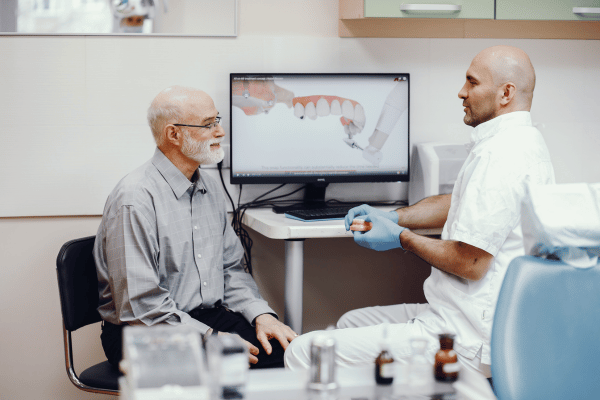
Table of contents
Hey there, fellow smile enthusiast! Have you ever noticed that your teeth aren't quite in their ideal teeth alignment as they previously were? Teeth shifting is the term for it. We'll look into common risks, highlight the need for practical treatments, and recognize the warning signs of shifting teeth today. You have your toothbrush now, so let's get started!
What Exactly Is Teeth Shifting?
Let's begin with the fundamentals. In short, teeth shifting is the gradual moving of your teeth from their original position. It is like a quiet, understated ballet taking place inside your mouth, but instead of turning carefully, your teeth may be moving accidentally. Teeth shifting can show up as crowding, uneven bite patterns, gaps between teeth, loose teeth, or even changes in dental alignment. These changes can happen to both adults and children, and they can have a number of reasons.
Recognizing Age-Related Teeth Shifting: Why Your Smile Alters Over Time
Have you ever noticed that your smile no longer looks quite the same as it did when you were younger when you look in the mirror? You're not by yourself. Our teeth frequently begin to shift as we get older, changing the appearance of our smile. However, why does this occur and what can we do to stop it? Let's explore the interesting topic of teeth changing with age.
The Aging Process Naturally
Let's start by discussing the reasons behind our teeth shifting with age. The aging process itself is just one of the key causes. Our bodies undergo a variety of changes as we age, and our teeth are no different. Our jawbone may become less dense with time, providing our teeth with less support. As a result of this lack of support, our teeth may progressively drift out of alignment.
Modifications to Jaw Structure
As we become older, the density of our jawbones may diminish, which lessens the support that our teeth receive. Our teeth may progressively move out of alignment as a result of this loss of support, much like a home without a solid foundation.
Wear and Tear
Consider all the daily tasks that your teeth perform, including biting, chewing, and occasionally even grinding. It should come as no surprise that teeth might shift due to wear and tear over time. Just like your best pair of shoes, they ultimately begin to exhibit indications of deterioration.

Habits
Do you frequently, especially at night, clench your jaw or grind your teeth? That might be part of the evolving story. The condition known as bruxism places additional pressure on your teeth, which over time may cause them to shift. It's not the greatest way to start the day—kind of like doing damage to your teeth while you sleep.
Signs and Symptoms of Teeth Shifting
Tooth shifting is caused by a number of reasons, including:
Teeth Movement
Noticeable tooth movement or displacement from their original placements is one of the main indicators of tooth shifting.
Bite Abnormalities
When your teeth move, it might result in an uneven bite, which can hurt or be difficult to bite or eat.
Spaces and gaps
When teeth move, they might leave behind spaces and gaps where they used to be closely spaced.
Crowding
Moving teeth around can result in overcrowding, which makes it difficult to clean them effectively because they are closely spaced and may even overlap.
Loose Teeth
Shifting teeth can result in teeth that are loose, which can be concerning and may point to underlying problems
Aging
As we become older, our bones and tissues alter, causing our teeth to move.
Dental conditions
Tooth shifting can result from weakening of the support structures caused by periodontal disease, tooth decay, or other dental issues.
Lifestyle and Habits
Teeth can shift as a result of pressure from oral behaviors such as tongue thrusting, bruxism, or using teeth as tools.
The Risks of Changing Teeth
Now that we know the cause of tooth shifting, let's discuss the risks. Teeth shifting can cause a number of problems, such as:
Bite Issues
When teeth are misaligned, it can have an impact on how your upper and lower teeth meet when you bite down. This may result in problems like jaw pain or trouble chewing.
Oral Health Concerns
Your risk of dental decay and gum disease can increase due to shifting teeth, which can leave gaps and crevices where food particles and germs can gather.
Aesthetic Modifications
Of course, the appearance of your smile is also impacted. Teeth shifting can change the appearance of your grin overall, which may have an impact on your self-esteem and confidence.
Heightened Teeth Sensitivity
Teeth that were previously protected may become more sensitive as a result of teeth shifting. This increased sensitivity may affect general oral comfort and make it difficult to consume hot or cold foods and beverages.
Effective Solutions for Teeth Shifting
While some teeth shifting may happen naturally, there are things you can do to stop or control bigger shifts:

Frequent Dental Checkups
Make an appointment on a regular basis to enable your dentist to keep an eye on your oral health, see any early indications of shifting teeth, and offer advice as needed.
Orthodontic treatment
It could be advised to undergo orthodontic treatment if there is a considerable shift in the teeth. In order to realign teeth and fix uneven bite patterns, orthodontic tools, transparent aligners, or braces might be used.
For more information about clear aligners, you can call (888) 861-1884.
Retainers
Following orthodontic treatment, using the retainers that your dentist or aligner provider prescribes will help you keep your teeth in their proper alignment and avoid recurrence.
Oral hygiene
Maintain proper oral hygiene by using mouthwash, flossing often, and brushing your teeth twice a day. Maintaining good dental hygiene lowers the chance of tooth decay and gum disease, both of which can cause shifting of teeth.
Modifications to your lifestyle
Steer clear of practices that put undue strain on your teeth, such as biting your nails, utilizing your teeth as tools, or chewing on ice or pens.Wearing a mouthguard when playing sports might also shield your teeth against injury that can cause shifting.
Conclusion
Teeth Shifting is a typical aging occurrence that many people encounter. We may take preventative measures to maintain our smiles looking their best for years to come by being aware of the causes, hazards, and solutions. Thus, keep brushing, keep smiling, and never forget that you may always get your teeth back on track!
Take a free smile assessment today to start your teeth straightening journey.
FAQs
1. Why do our teeth move as we get older?
Age-related tooth shifting can be caused by a number of factors, such as alterations in the anatomy of the jaw, deterioration of the teeth with time, and clenching or grinding behaviors.
2. Can one avoid having their teeth shift?
While some degree of teeth shifting is inevitable as people age, there are things you can do to reduce the amount of shifting. These include treating underlying conditions like bruxism and practicing proper oral hygiene.
3. What are some efficient methods for moving teeth?
Orthodontic therapy, such as braces or clear aligners, wearing retainers, and treating any underlying problems that may be causing the shifting are some solutions for moving teeth.
3. How can I keep my teeth looking good as I get older?
It's critical to prioritize maintaining proper oral hygiene practices, schedule routine checkups with your dentist, and seek fast treatment for any dental issues if they arise in order to preserve a healthy smile as you age.


